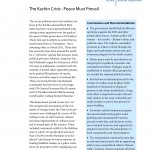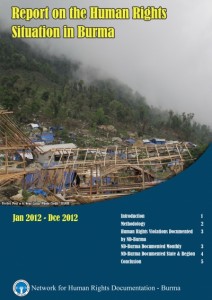Crimes Against Humanity (194 found)
Update of Human Right Violations by the Burma Army During Offensives in Palaung Areas (March and April 2013)
Since January 2013, Burmese government troops have been carrying out military offensives in Palaung areas against the Shan State Army-North (SSA-N), Kachin Independence Army (KIA) and Ta’ang National Liberation Army (TNLA). The Burmese troops have committed widespread human rights violations during these operations […]
• • •“All You Can Do is Pray”: Crimes Against Humanity and Ethnic Cleansing of Rohingya Muslims in Burma’s Arakan State
Crimes Against Humanity and Ethnic Cleansing of Rohingya Muslims in Burma’s Arakan State
This 153-page report describes the role of the Burmese government and local authorities in the forcible displacement of more than 125,000 Rohingya and other Muslims and the ongoing humanitarian crisis […]
• • •Human Rights Violations Perpetrated Against the Chin in Burma (March 2011 – March 2013)
Documentation from human rights groups shows that in fact, serious human rights violations continue across the country under President Thein Sein’s government, with particularly severe consequences for ethnic and religious minorities. For the predominantly Christian Chin people, this includes violations of religious freedom, forced labour, sexual violence, and extra-judicial killing, despite the fact that a ceasefire between armed resistance group the Chin National Front (CNF) and the government is holding […]
• • •Resolution on the Situation of Human Rights in Myanmar
The full text of the United Nations Human Rights Council Resolution that calls on the government to end human rights violations and ensure accountability and end impunity, maintains the resolution under agenda Item 4 of “Human rights situations that require the Council’s attention” and also extends the mandate of Special Rapporteur on human rights in Burma, Tomás Ojea Quintana.
• • •The Kachin Crisis: Peace Must Prevail
 The recent political unrest and military violence in the Kachin and northern Shan states has been on an unprecedented scale, raising serious questions over the goals of the quasi-civilian government of President Thein Sein and its ability to control the national armed forces (Tatmadaw). Since assuming office in March 2011, Thein Sein has received praise from around the world for a “reformist” agenda that has seen many political prisoners released, Aung San Suu Kyi’s National League for Democracy (NLD) win seats to parliament, ceasefires with the majority of armed ethnic opposition groups, and a gradual liberalisation of media, business and other aspects of national life. These are trends that the international community has been keen to encourage, with UN General-Secretary Ban Ki-moon and US President Barack Obama among world leaders visiting Burma/Myanmar […]
The recent political unrest and military violence in the Kachin and northern Shan states has been on an unprecedented scale, raising serious questions over the goals of the quasi-civilian government of President Thein Sein and its ability to control the national armed forces (Tatmadaw). Since assuming office in March 2011, Thein Sein has received praise from around the world for a “reformist” agenda that has seen many political prisoners released, Aung San Suu Kyi’s National League for Democracy (NLD) win seats to parliament, ceasefires with the majority of armed ethnic opposition groups, and a gradual liberalisation of media, business and other aspects of national life. These are trends that the international community has been keen to encourage, with UN General-Secretary Ban Ki-moon and US President Barack Obama among world leaders visiting Burma/Myanmar […]
Report on the Human Rights Situation (January – December 2012)
 The annual report of Network for Human Rights Documentation – Burma (ND-Burma) documented the human rights situation in Burma from December 2011-January 2013. The report provides information on human rights violations (HRVs) over this period and highlights pressing issues and trends taking place in Burma. The annual report covers human rights violations in 16 categories over all 14 states. Unsurprisingly, the highest incidences of abuse occurred in ethnic nationality areas that remain in open conflict with the Burma Army, the Tatmawdaw, or are the grounds for controversial development projects […]
The annual report of Network for Human Rights Documentation – Burma (ND-Burma) documented the human rights situation in Burma from December 2011-January 2013. The report provides information on human rights violations (HRVs) over this period and highlights pressing issues and trends taking place in Burma. The annual report covers human rights violations in 16 categories over all 14 states. Unsurprisingly, the highest incidences of abuse occurred in ethnic nationality areas that remain in open conflict with the Burma Army, the Tatmawdaw, or are the grounds for controversial development projects […]
State Terror in the Kachin Hills
In late 2012, the Burma Army intensified military operations against strongholds of the Kachin Independence Army (KIA). This culminated in a massive offensive on the KIA headquarters at Laiza on the China-Burma border starting in mid-December […]
• • •The War in Kachin State: A Year of More Displacement and Human Rights Abuses
In the past year, the Tatmadaw has deployed nearly 25% of its battalions to Kachin State, escalating its war with the Kachin Independence Army (KIA) and bringing further suffering to civilian populations in Kachin State and Northern Shan State.
Tatmadaw soldiers have constantly targeted civilians in Kachin State and Northern Shan States as part of their military operations against the KIA. Human rights abuses have included extrajudicial killings, rape of women, arbitrary arrests, torture, forced displacement, the use of human shields, forced labor, and the confiscation and destruction of property. All of these systematic abuses would be considered war crimes and/or crimes against humanity under international law […]
• • •Ongoing Impunity: Continued Burma Army Atrocities against the Kachin People
This report provides an update of atrocities committed by the Burma Army against civilians since it broke its 17-year ceasefire with the Kachin Independence Army (KIA) one year ago. It highlights the particular suffering of women during the conflict, who have been forced to be porters, used as sex slaves, gang-raped and killed […]
• • •Extreme Measures: Torture and Ill Treatment in Burma since the 2010 Elections
This report documents the Government of Burma’s torture and ill treatment against its own people since the 2010 elections. This report demonstrates that the Burmese government continues to commit these abuses despite being bound to international human rights treaties and norms. Furthermore, the lack of domestic legislation prohibiting torture, the absence of an independent judiciary, and an ineffective Human Rights Commission contribute to a climate where torture and ill treatment are perpetrated with impunity […]
• • •
 All posts
All posts